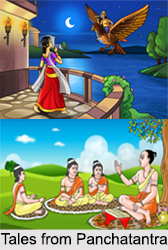 Panchatantra is a compilation of inter-woven series of tales in prose and poetry, mostly animal fables. Tales of this ancient Indian work, the original texts of which is now long lost, portray the origins of the subcontinent"s language and primitive lifestyle. The collection of fables in Panchatantra reveals the basic knowledge of wisdom that makes one"s life "richer, happier and fuller".
Panchatantra is a compilation of inter-woven series of tales in prose and poetry, mostly animal fables. Tales of this ancient Indian work, the original texts of which is now long lost, portray the origins of the subcontinent"s language and primitive lifestyle. The collection of fables in Panchatantra reveals the basic knowledge of wisdom that makes one"s life "richer, happier and fuller".
Panchatantra is one of India"s most influential contributions to world literature. Through cross-border mutations, adaptations and translations, the Panchatantra remains the most popular work of literature.
Compilation of Panchatantra
Panchatantra has been composed by Vishnu Sharma and is considered by most scholars to be dated around 3rd century BCE. It is based on older oral traditions. Panchatantra was compiled in Sanskrit and Pali languages.
Divisions of Panchatantra
Many colourful fables have been inter-woven in Panchatantra. It starts with an introduction about the author. The rest of the composition is shown as a narration to the princes that constitute five parts.
Each of these parts contains a main story known as the frame story which again contains several stories in it. It is like one character narrating a story to another. The characters quote various epigrammatic verses in order to make their point. The Panchatantra consists of 5 parts which are as follows:
1. Mitra-Bheda: Separation of Friends (The Lion and the Bull)
2. Mitra-Labha or Mitra-Samprapti: Gaining of Friends (The Dove, Crow, Mouse, Tortoise and Deer)
3. Kakolukiyam: War and Peace (The Crows and Owls)
4. Labdhapranasam: Loss of Gains (The Monkey and the Crocodile)
5. Apariksitakarakam: Rash deeds (The Brahman and the Mongoose)
Mitra-Bheda: In Mitra-Bheda, the lion (Pingalaka) who is the king of the forest and a bull (Sanjivaka) become friends. Karataka and Damanaka are two jackals who are retainers to the lion. Damanaka breaks the friendship between the lion and the bull as he became jealous. This has around thirty stories that have been narrated by the two jackals. It is the longest of the five books.
Mitra-Labha or Mitra-Samprapti: In Mitra-Samprapti the story of the crow has been narrated. The crow upon seeing the favour the rat did to the dove and her companions, decides to be a friend of the rat despite the rat objecting initially. The friendship grows and it also includes the turtle and the fawn. They team up to save the fawn when he is trapped as well as later work together to save the turtle that falls in the trap.
 Kakolukiyam: Kakolukiyam deals with a war that takes place between crows and owls. One of the crows pretends that he is an outcast from his own group. He does this so that he can gain entry into the rival owl group and thereby can gain access to their secrets and learn of their exposure. He later tells his group of crows to set fire on all entrances to the cave where the owls live.
Kakolukiyam: Kakolukiyam deals with a war that takes place between crows and owls. One of the crows pretends that he is an outcast from his own group. He does this so that he can gain entry into the rival owl group and thereby can gain access to their secrets and learn of their exposure. He later tells his group of crows to set fire on all entrances to the cave where the owls live.
Labdhapranasam: Labdhapranasam deals with the artificial symbiotic relationship between the monkey and the crocodile. The crocodile conspires to acquire the heart of the monkey to heal his wife. When the monkey comes to know of this he avoids this severe destiny.
Apariksitakarakam: In Apariksitakarakam, a Brahman leaves his child with a mongoose friend of his. When he returns he finds blood on the mongoose`s mouth, he kills it. Later he comes to know that the mongoose actually protected his child from a snake.
Panchatantra is a unique collection that has equally delighted the young and the old, educated and uneducated, rich and poor, high and low – for over two thousand years. It has triumphed over the greatest obstacles of language, custom and religion and continues to delight everyone to this very day.












